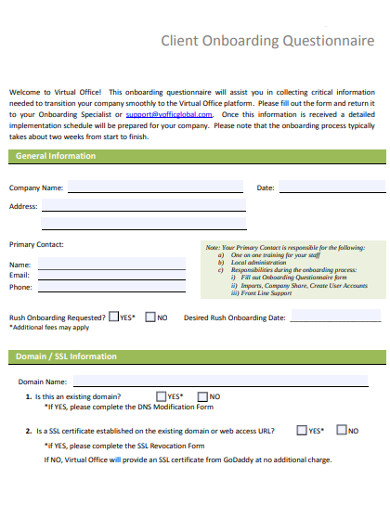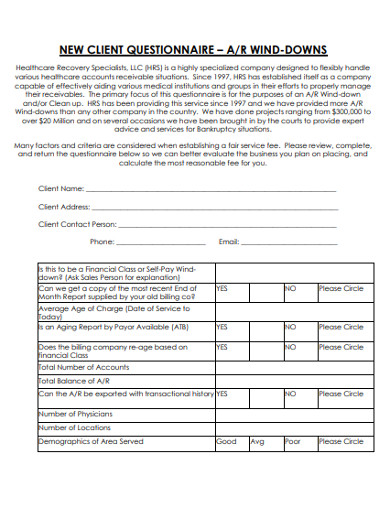Client Onboarding Questionnaire Examples
After your marketing and sales strategy worked, you would want to keep your new clients from walking out the door. Otherwise, it would just be a cycle of find-and-replace that will consume much of your resources with little financial gain. Client onboarding is the process of convincing your new customers that your company is the right match for their project and their goals. It is about giving them the reason to stay because you can give them the best in the industry.
Business is a give-and-take relationship between your company and your clients. You spend your resources on getting new clients, and they contribute to your company’s profit. But if you cannot provide what they need, your customers will look for a company that can, A.K.A., your competitor. When your clients come onboard, the next step is making that relationship last. Discover how you can be the platform for unparalleled customer service with client onboarding questionnaires.
Picture the questionnaires as an instruction manual on how you can manage and deliver your clients’ expectations on a project. Instead of just feeling around in the dark, you get a clear image of how you are going to proceed with the work, given the information. While you still have to run your team’s plans with the client, you will make a better impression when you are not entirely clueless about what the client expects from you. It also adds confidence to the client’s end that the project is in knowledgeable hands. When your customers feel that they can trust your company and what you offer, they are likely to return to you for more projects and purchases.
Returning clients are an asset to your company. You are earning more from returning clients than those that you have just taken in. This is because, at the start, both you and your new clients are spending a significant amount to convince each other that you are a match. You are also spending on marketing and sales strategies to enlist them. Selling your products and services to potential customers also gives a low success rate. However, you are spending less for more benefits on returning clients. Because these people trust your company, they are likely to spend more. They are also more willing to go for your more expensive offers. It is easier to market and sell your products and services to them. It is sustainable for your business to nurture lasting relationships with satisfied clients than keep generating short-lived transactions with uncommitted people. But, client satisfaction with the relationship isn’t just found in what you can do for them. They themselves should also understand the products, services, and processes present in your company.
Maintaining the relationship should not just come from one end. The client onboarding process helps them adjust and ease into the environment of your business. During the onboarding phase, you brief the new clients about what there is to know to make their projects with you a successful and satisfying experience. You can give them an insight into the nature of the services that you provide. The information you give them should help them understand their role in the arrangement and help manage their expectations as well. As a supplier or service provider, you would want your clients to be satisfied with your performance and output. They may be expecting a different outcome than what you can provide. It is for the best that you can communicate differences and clear any confusion early on.
2+ Client Onboarding Questionnaire Examples & Templates
Set the right tone for your business-client partnership using client onboarding questionnaires! The following sample templates will help you get started on your next project.
1. Sample Client Onboarding Questionnaire Example
2. Basic Client Onboarding Questionnaire Example
3. New Client Onboarding Questionnaire Example
The Client Onboarding Process
How do you turn your prospects into clients and keep them at that?
1. Review the Requirements
Before you can welcome the client, you must already have properly closed the client acquisition process. For example, the client has accepted your project proposal and you have discussed your terms. Your client should also have signed a solid contract that will protect your company and your client. The agreed amount and terms of payment for your products and services should have also been received and accounted for.
2. Ask the Right Questions
While it is for the best that businesses know themselves well, this might not be true for all. Some may just be starting to make their mark and are in need of your help. Others may just be barely getting by in the industry with the shaky foundation that they have. In any case, you have the chance to change that so you might as well. Before you hand them the client onboarding questionnaire, make sure that they know what to put into the form. Consider having them over for a discussion about their business and the design of the project itself. What sets them apart from the competition? What are their long-term goals? What are their objectives for this project they are consulting you with? This way will refine their answers in the questionnaire. The answers would be more specific, hence, more useful.
3. Get the Team Acquainted
The company representatives who will meet with the clients must have excellent listening skills. Since your team is sent to welcome the client onboard, the meetings are the time where you can gain your clients’ confidence, as well as ask them questions. The questionnaires may not be able to capture the client’s philosophy, the nature of the business, and the end goal of the project down to the last detail. If there is confusion from any party, this should be aired out and cleared before the project is started. You should also have something to present to your client during this time, like the goal of the team, the project timeline, and the responsibilities of each member. Build your plan around the information you learned from the meetings. You can use your questionnaires to supplement what you know.
4. Give Regular Updates
Regularly update your client on the progress of the project. During the duration of the project, allow the communication lines to be open for questions and feedback. Should your client raise concerns, you should address these promptly. Quick response and solution to issues show that you are striving to deliver good service for them. This leaves a good impression on your customers. From the meetings and questionnaires, you have to know the way that you can get in touch with your clients in their preferred method. Maybe they want to be personally updated during regular meetings. Maybe they would want to be sent an e-mail regarding the progress.
You have to get to know your clients, their business and their project well. You have to understand their goals and expectations. That way, you can give them the service they hoped for from your company. At the same time, they also have to understand what it is that you do and that you also have your own boundaries in the job. Client onboarding gives you the platform to give the client relationship a promising start and settle questions and confusion before you proceed with the project.





